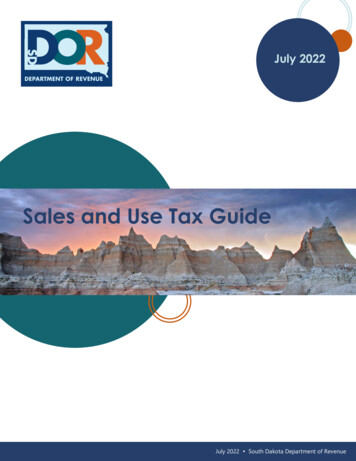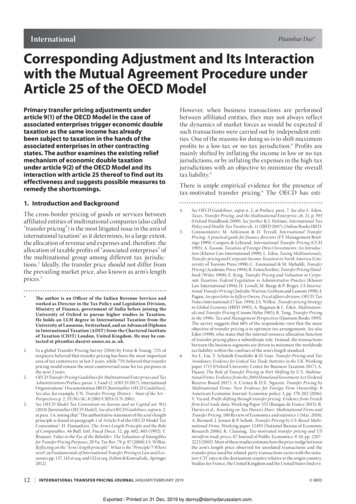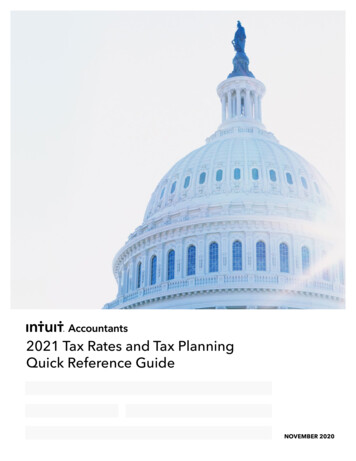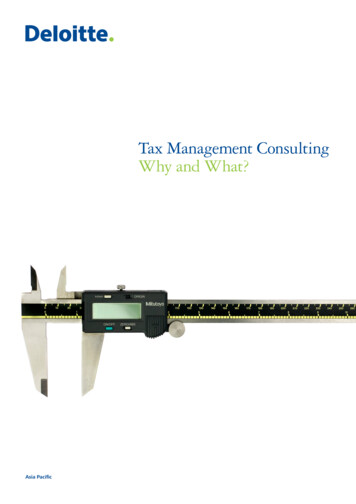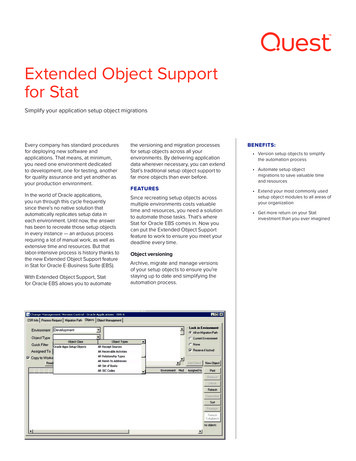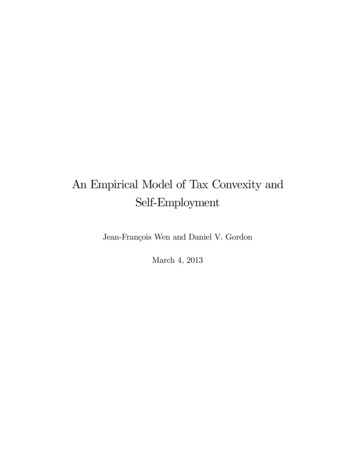
Transcription
An Empirical Model of Tax Convexity andSelf-EmploymentJean-François Wen and Daniel V. GordonMarch 4, 2013
AbstractDo progressive marginal income tax rates discourage self-employment? We assume riskneutrality to construct an implicit surtax on stochastic income relative to steady income,arising from a convex tax schedule. It is computed as part of a structural probit modelwith earnings equations and a tax simulator. The tax convexity variable and the net-of-taxincome di erence between self- and paid-employment have the predicted signs and high levelsof statistical signi cance for the probability of self-employment. A simulated ‡at tax reformsuggests the tax e ects are small.JEL: H24, J24, C35
1IntroductionEntrepreneurship is regarded as vital for generating employment and innovation. It is also a risky occupation with high potential returns and high failurerates. Since the income tax system alters the relationship between risk andreward, its design may be an important determinant of entrepreurial activity. For example, a revenue compensated increase in the rate of a linearprogressive tax is expected to raise the share of the workforce engaged inentrepreneurship.1 A plausible view, however, is that progressivity achievedwith a rising marginal tax rate schedule is likely to discourage entrepreneurship because the higher tax rates penalize success by more than the lowertax rates provide relief against poor returns.Self-employment is frequently used as a proxy for entrepreneurship in empirical studies. The proxy is imperfect since only a portion of self-employedindividuals ever innovate or hire employees. The policy implications of thisfact are addressed later. Nevertheless, one way to examine the tax penaltyhypothesis empirically is to estimate the e ects of the tax system on thechoice between self-employment and employed labor. In this paper, we develop a structural model of earnings and discrete occupational choice witha focus on our “tax convexity” variable characterizing the size of the taxpenalty on activities that result in ‡uctuating incomes under marginal taxrate progression.Tax convexity is measured by Gentry and Hubbard (2000, 2005) as thespread in the marginal (or average) tax rates for successful and unsuccessfulself-employment outcomes, de ned relative to the ability of each individual.It is clear why high tax rates in the event of success may discourage entrepreneurial risk-taking. It is less evident why low tax rates in the case of1An income tax can encourage risk-taking because it reduces the variance of net-of-taxincome (Domar and Musgrave, 1944). Linear progressivity positively impacts entrepreneurship, innovation, and growth in García-Peñalosa and Wen (2008). In Kanbur (1981)and Clemens and Heinemann (2006) the e ect of redistributive taxation on entrepreneurship is ambiguous due to the general equilibrium e ects on rm sizes and wages.1
failure would discourage it. Gentry and Hubbard provide two illustrations ofwhy the size of the downside component of tax convexity may be negativelycorrelated with self-employment rates. First, an imperfect loss o set in theevent of failure corresponds to a low tax rate applied to losses. Second, sincethe alternative to self-employment is to work for wages, a comparatively lowtax rate in the bracket encompassing wage earnings increases the opportunitycost of self-employment. In both of these examples, small tax rates in themiddle to lower tax brackets discourage self-employment. Although the examples show the potential relevance of Gentry and Hubbard’s tax convexityvariable as a negative correlate of self-employment rates, the approach depends on particular con gurations of self-employment and wage employmentearnings. Loss o setting, for example, is not relevant to an entrepreneurearning low but positive pro ts.A more direct way to measure tax convexity is to calculate the expectedvalue of the tax liability of an entrepreneur facing a distribution of possiblereturns and to compare this burden with the same individual’s tax liabilityat their predicted income. If high marginal tax rates on successful entrepreneurs penalize success more than low marginal tax rates provide a form ofindemnity in the case of business failure, then the expected tax liability willexceed the tax liability of the predicted income. The implicit surtax on riskyincome may discourage self-employment relative to paid employment, whichusually provides a more stable source of income.2 This idea is implementedin our empirical work. Speci cally, we calibrate person-speci c income distributions from an estimated self-employment earnings equation and we usethese in conjunction with a tax simulator to compute a tax convexity variablefor each person. The variable expresses the implicit surtax as a proportion ofnet income (consumption). The predicted negative impact of tax convexity2For example, a taxpayer in Ontario in 2012 without dependents who earns 60,000 oftaxable income in one year and 20,000 the next would pay 16 percent more in incometaxes compared with the same individual earning 40,000 in both years.2
on self-employment assumes risk-neutrality.3 Another important concept inour model is the net-of-tax income di erence between self-employment andemployment for every individual evaluated at their predicted incomes fromthe earnings equations.The e ects of progressive taxation on the probability of self-employmentare estimated with a probit model using Statistics Canada’s cross-sectionalpublic-use microdata les from the Survey of Labour and Income Dynamics(SLID) over the years 1999-2005. The period spans an important income taxreform in Canada in 2001. The Canadian Tax and Credit Simulator (CTaCS)developed by Milligan (2007) is used to calculate the total federal and provincial tax and transfer implications of the employment/self-employment choicefor each individual in our data. The tax parameters in CTaCS include federaland provincial income taxes, payroll taxes, tax credits, and income transfersand their clawbacks, all of which matter for tax convexity and net-of-taxdi erentials.Previous work on the e ects of tax convexity on occupational choice hasfocused exclusively on the United States. The income tax system in Canadadi ers in important respects from the U.S. tax system. The personal andcorporate income tax systems are integrated in Canada for incorporated businesses earning up to 500,000 (in 2012). This is achieved with a personaldividend tax credit that o sets corporate taxes.4 In contrast, in the U.S. thetax structure provides an incentive to shift labor income to corporate incomewhen income realizations are large.5 There exists a 500,000 lifetime capitalgains exemption on small business shares in Canada, which has no equivalentin the U.S. Marginal tax rates are higher in Canada and the rates apply toindividual taxpayers, rather than to married couples as in the U.S. These andother comparative features of the Canadian tax system provide an alternative3If agents are risk-averse, they derive an insurance bene t from progressive taxation,which is entangled with the implicit surtax on risky income, as we show later.4The integration arises only if the corporation pays dividends.5See Cullen and Gordon (2007) for the impact of this tax feature on self-employment.3
scal setting to explore the e ects of tax progressivity on self-employment.Studies on the e ects of taxes on self-employment have mainly estimatedreduced form equations, which specify the self-employment choice as a function of variables thought to determine labor market outcomes, such as education, experience, age, capital, occupation, marital status, parenthood,and labor market conditions, along with marginal or average tax rates.6 Aless common approach utilizes structural models derived formally from theself-employment decision as a function of the earnings di erential betweenself-employment and wage work. Only the studies by Bruce (2000), Parker(2003), and Fossen (2007, 2008) estimate structural models containing earnings equations and net-of-tax income di erentials in place of gross incomedi erentials as determinants of self-employment; none include measures oftax convexity. As shown by Gentry and Hubbard (2000, 2005), the omissionof tax convexity considerations may be important for understanding howtaxation a ects occupational choice.7We nd that the probability of self-employment is negatively related toour tax convexity variable and is positively related to the net-of-tax incomedi erential between self-employment and employment, both with high levels of statistical signi cance.8 However, the sizes of the impacts of the taxvariables appear to be small. This observation is based on the outcome ofa policy simulation with our estimated model. We simulated the e ect ofchanging the Canadian federal income tax in year 2000 to a ‡at tax rate of20 percent. The projected increase in the average self-employment rate from6See the surveys by Le (1999) and Schuetze and Bruce (2004).Our focus is the rate of self-employment, as in, e.g., Rees and Shah (1986) and Bernhardt (1994), rather than on occupational transitions, as the public-use SLID les do notfacilitate longitudinal analysis.8Fossen (2007), Fossen and Steiner (2009), and Hansson (2012) nd negative relationships between income tax rates and self-employment. Ferede (2011) nds that greatermarginal tax progressivity reduces self-employment rates in aggregate data for Canadianprovinces. However, most studies conclude the contrary result, which is often attributed tothe incentive for tax avoidance or tax evasion at high marginal tax rates (e.g., Long, 1982,Blau, 1987, Parker, 1996, Robson and Wren (1999), Bruce, 2000, and Schuetze, 2000).74
the tax reform is about 3 percent for individuals in the sample with predictedannual incomes above 50,000 and 1 percent for the working population asa whole.The rest of the paper is organized as follows. Section 2 explains thetheory that guides our empirical model. Section 3 describes the data. Section4 provides the empirical speci cations and discusses issues of self-selectionand identi cation. Section 5 presents the results. Section 6 reports thehypothetical ‡at tax simulation. Section 7 concludes.2Theory2.1Progressive Tax FunctionDenote individual i’s before-tax income in occupation j by yji and aftertax income by xij . Represent income tax progressivity using the function(Musgrave and Thin, 1948, and Benabou, 2000):xij yji1yb(1)where 0 1 and yb 0 are parameters of the tax system. At theincome level yb the taxpayer’s tax liability is zero. The term 1is theelasticity of after-tax income with respect to before-tax income. Higher values of correspond to more redistributive tax systems (Jakobsson, 1976).The expression “tax convexity” conveys the fact that the tax liability function T (yji )yji xij yji 1 (by yji ) is strictly convex. Marginal taxrates are characterized by dT dyji 1 (1)(by yji ) and d2 T (dyji )2 (1)(by yji ) yji 0. The implication of tax convexity is that a stochasticincome generates a larger expected tax liability than the tax liability associated with the expected income.99Note that the curvature of the tax schedule is increasing in untilit decreases. The empirically relevant range is 1 2 (Ferede, 2011).5 1 2 and then
2.2Occupational ChoiceUtility is assumed to depend on after-tax income (consumption) and on anhedonic index Qij of non-pecuniary job characteristics associated with anoccupation j. The index is composed as follows:Qij Xin qnj(2)nwhere qnj is the measure of a non-pecuniary job characteristic in occupationj and in is its utility weight. Following Rees and Shah (1986), let the utilityfunction bebiuij U (xij ; Qij ) xij exp di Qij(3)where di and bi are preference parameters; risk aversion is decreasing with biand non-pecuniary considerations increase with di .Before-tax income is assumed to be lognormally distributed:yjiLN ( ij ;ij ):Substituting (1) for xij into (3) givesuij yji(1)biybbiexp di Qij :(4)An individual i chooses the occupation j 2 fS; Eg (representing self-employmentand employment, respectively) that maximizes expected utility E(uij ). Usingproperties of the lognormal distribution (Aitchison and Brown, 1966, Theorem 2.1),Eh(1yji)bii)bi exp (1ij 1(12)bii 2j:Thus maximizing expected utility in (4) is equivalent to maximizing the6
following utility index:Vji (Qij ; y ij ; cij ) (1y ij) ln y ij1(12)(1 bi (1)) ln 1 (cij )2 exp 21 ( ij )2of variation of yji .E(yji )ijyjicijdi Qij; (5)biq exp( ij )2is the mean of and1whereis the coe cientExpected utility is higher with self-employment compared with employment if C iVSi (QiS ; y iS ; ciS ) VEi (QiE ; y iE ; ciE )0. Using (5), C i0 isequivalent to(1) lny iSy iE1(12bi (1)) ln1 (ciS )2(1 (ciE )2 diQiSibQiE0:(6)The appearance of the term (1) as a multiplicative factor on the lefthand side of (6) indicates that greater tax progressivity (higher ) reducesthe relative importance of nancial di erences, both reward and risk, indetermining occupational choice. We can decompose the tax e ects in (6)into two parts.The rst term (1) ln y iS y iE in (6) can be interpreted as the percentage change in after-tax income that results from switching occupationsfrom employment to self-employment, evaluated at the expected income fromeach occupation. In the econometric model this variable is called “NetIncdif.”Hence, we would expect the estimated coe cient on NetIncdif to be positivein a probit equation for self-employment. The second appearance of a taxterm is less familiar and relates to tax convexity.2.3Tax ConvexityConsider the second tax term in (6):1(12)(1bi (1)) ln71 (ciS )2(1 (ciE )2:(7)
We would normally expect ciS ciE , as self-employment is associated withentrepreneurial risk-taking.10 Set ciE 0 to represent the relative safety ofpaid-employment and suppose that individuals are risk-neutral, so bi 1.In that case, the term (7) (in absolute value) reduces to an expression thathas a simple interpretation. It is the increase in tax liability taken on byself-employed individuals due to the volatility of their earnings, expressed asa proportion of their disposable income:E[T (ySi )] T (y iS )xiS) ln 1 ciS(1 2)(12;(8)where T (y iS ) is the tax burden at the expected self-employment income andy y iS ) is the net-of-tax income at y iS .11 We construct the taxxiS y iS (bconvexity variable in our empirical model using a logarithmic formulation of(8),E[T (ySi )] T (y iS )Tax Convexity T (y iS )T (y iS )xiSE[T (ySi )]T (y iS )lnT (y iS )(9)xiSand we refer to it as “Convexity.”The predicted sign on Convexity is unambiguously negative (see (7)).12In the case of risk aversion (0 bi 1), the e ect of tax convexity isgiven by (7), which contains an interaction of and bi . Smaller values of bi(greater risk aversion) weaken the magnitude of the negative impact of taxprogressivity on self-employment due to the insurance e ect of redistributivetaxation.1310Gentry and Hubbard (2005) provide evidence that self-employed individuals facegreater income ‡uctuations across years than do employed individuals.11It is straightforward to show that E(T (ySi ) T (ySi ) xiS 1 ez , where z (1 2) (12) ln(1 ciS ). Since 1ez 2z z22! z33! ::: , then for small z,ezz (1 2) (1) ln(1 ciS ).We estimate coe cients of NetIncdi and Convexity without restricting their magnitudes to be the same.13Mathematically, d2 [ (1 2)(1)(1 bi (1))] (d db) (1) 0. The fact1128
We assume risk neutrality in our empirical work. If agents are in fact riskaverse, then the coe cient of the Convexity variable will be biased downwardin our probit regression. To see this, note that a generalized convexity measure based on (7) can be written as the sum of two terms, i.e.,(1 2)(1 (1 2)(1)(1bi (1)) ln 1 (ciS )22) ln(1 ciS ) (1 2)(1bi )(12)2 ln(1 ciS ):(10)The rst term in (10) is the same as the tax convexity measure derived underrisk neutrality and given by (8). The second term is zero if agents are riskneutral but positive if agents are risk-averse. The two terms in (10) shouldbe positively correlated if all agents are similarly risk-averse (bi b 1; 8i)with variation in the terms stemming from ciS . Since the predicted sign of thecoe cient on Convexity is negative, there would be negative omitted variablebias (Wooldridge, 2009: 91). This implies that if agents are risk-averse,our estimated probit regression would overstate the negative impact of theConvexity variable on the probability of choosing self-employment. However,the potential size of the bias is dampened if the coe cient of relative riskaversion, 1 bi , in the second term of (10) is negatively related to the size ofrisk, ln(1 (ciS )2 ), due to self-selection into entrepreneurial activities by lessrisk-averse persons (see Kihlstrom and La ont, 1979). The evidence providedby Kan and Tsai (2006) is that risk tolerant individuals are relatively morelikely to become self-employed.We do not observe the non-pecuniary aspects embodied in the hedonic indexes and di . Observable variables believed to a ect occupational choice areused as proxies for the unobservable characteristics in the empirical model.Finally, note that self-employment and paid-employment determine anindividual’s labor earnings, but the total tax liability and consumption depend also on investment income, alimony payments, and so on. In otherthat tax convexity discourages self-employment regardless of the degree of risk aversion in(7) is due to assuming constant relative risk aversion.9
words, total income isyji eij ai ;(11)where eij is labor earnings of i in occupation j, and ai is i’s non-labor income.We take ai as exogenous when calculating an individual’s tax liability but wepredict eij with econometric equations.3DataThe model is estimated with Statistics Canada’s public-use microdata lesfrom the Survey of Labour and Income Dynamics (SLID). This is an anonymizedcollection of income, labour, and family variables on persons in Canada derived from the longitudinal SLID. In a given year, the longitudinal SLIDconsists of two overlapping panels with a new panel introduced every threeyears. The sample frame for the survey covers all individuals in Canada.We use annual cross-sections of individuals who report their main activityas working, covering the seven year period 1999-2005 for a total of 142,278observations of which 8,674 are de ned as self-employed. The SLID dataprior to 1999 omits several explanatory variables, while 2005 was the lastavailable year for CTaCS during our study.The key variable of interest in our analysis is employment status. We de ne persons to be self-employed if they report their major source of earningsto be from self-employed work and they also report no farm income. Personsare de ned to be employed if they report their major source of earnings to befrom wages and salary and they also report no farm income. Thus, we construct a binary dependent variable equal to one if a person is self-employedand equal to zero when a person is employed as de ned above.1414The vast majority of individuals in our sample report either only self-employment income or only employment income. Few individuals obtain similar amounts of income fromboth occupations. This supports our assumption that individuals make a binary choicebetween self-employment and employment. Annual national rates of self-employment inour sample are 6.30 (1999), 5.72 (2000), 5.29 (2001), 6.65 (2002), 6.48 (2003), 6.02 (2004),10
The SLID Person File is used to download all variables associated withthe individual and this is then linked to the SLID Economic Family File tocollect household information. The variables obtained from SLID and used inthe empirical work are de ned in Table 1. The main earnings variable measures salaries, wages and self-employment income. Two variables that characterize the nancial status of individuals and are assumed to impact theself-employment choice are investment income and taxable capital gains.15We specify a number of control variables describing individual characteristics believed to a ect labor market outcomes such as age, gender, education,disability, marital status, and number of children in the household. To account for labor market conditions we control for unemployment spells andtype of employment (white collar, blue collar, and service).Table 2 shows summary statistics for the combined seven years. The datashow an interesting statistical picture of the self-employed versus employed.On average the self-employed have lower earnings and greater variation inearnings compared to the employed. This is consistent with the generalnotion that self-employed work is more risky. As well, the self-employedshow both higher average levels of investment income and capital gains, areslightly less educated, moderately older and more likely to be married andhave more children.6.46 (2005).15Blanch‡ower and Oswald (1998) nd evidence that nancial constraints are an important deterrent to self-employment. However, the issue is controversial. Hurst and Lusardi(2004) contest the previous evidence regarding liquidity e ects and show that the capitalrequirements for many entrepreneurial activities are small.11
44.1Empirical ModelConstructing the Tax VariablesThe variables NetIncdif and Convexity are constructed from estimated earnings equations. In general, the earnings equations can be written as,ln earnings j Zj "j(12)for j employed (E) and self-employed (S). Z is a vector of explanatoryvariables common to both equations and "j is an error term assumed to benormally distributed. A problem with least squares estimation of equation(12) is the possibility of omitted variable bias caused by self-selection intoemployed/self-employed classi cations. We follow the standard Heckman(1979) procedure to correct for omitted variable bias by estimating, for eachyear, a reduced form probit speci ed over the choice between employment andself-employment.16 From these equations the inverse Mills ratios are calculated for the self-employed and employed individuals and included in the appropriate earnings equation.17 The corrected earnings function is estimated,separately in each year, rst using data only for employed individuals, whichis used to generate predicted employment earnings for each individual in thedata set, both self-employed and employed. This operation is repeated by estimating the earnings equation using only the self-employment data and thenpredicting self-employed earnings for each individual in the data set. Whatwe obtain from this exercise is the expected earnings for an individual ifthat person had chosen self-employment or alternatively paid-employment.1816The Heckman correction will be identi ed with exclusion restrictions rather than functional form.17Under the assumption of normality of the error structure the inverse Mills variable isthe ratio of the normal density (') to the cumulative normal density ( ). For the selfemployed the inverse Mills ratio is de ned as '( ) ( ) and for employed labor it isde ned as '( ) (1( )) (Lee, 1978).18We correct for the downward bias caused by taking the exponential of predicted logearnings (see Wooldridge, 2009: 211).12
Next, the predicted earnings for self-employment and paid-employment foreach individual, together with their nancial and personal characteristics,are used in the CTaCS simulator to generate tax liabilities from each occupational choice. Finally, the predicted income (i.e. predicted earnings plusthe non-labor income reported in the data) and tax liabilities in each occupation are used to calculate the percentage di erence in after-tax incomebetween self-employment and employment (NetIncdif). This calculation isundertaken for every individual in each year of our sample. Note that sinceNetIncdif is (the log of) a ratio of incomes between self-employment and employment, price in‡ation across years poses no problem for pooling the sevenyears of data to estimate the structural probit equation. NetIncdi has amean value of -0.249 and a standard error of 0.287. The negative averagevalue of NetIncdi indicates that self-employment is typically less remunerative than employment. This underscores the importance of non-pecuniaryjob charactersitics in the occupational choice.Numerical simulations are used to compute Convexity. For every individual, we take 1,000 draws from a normal distribution with the conditionalmean equal to the predicted log of self-employment earnings from (12) andhS (Z), where bS is the standard error from rea conditional variance of b2S bbgression (12) and hS (Z) are the predictions of a heteroskedasticity functionthat is estimated using standard procedures to t the squared non-robustresiduals of (12) (Wooldridge, 2009: 283-284). The regression coe cients ofthe heteroskedasticity function are highly statistically signi cant. The assumption behind our method is that an individual’s perceived variation ofhis or her possible earnings from self-employment is adequately explained byobservable factors such as age, education, marital status, location, type ofjob, etc. The value of each draw is exponentiated and added to non-laborincome to obtain total income. Next, we use CTaCS to calculate the corresponding tax liability in each iteration. The expected tax liability of agiven individual in self-employment is a simple average from the 1,000 iter-13
ations.19 From the same set of simulations we obtain the tax liability at theexpected income [T (ySi )] and after-tax income [x ySi T (ySi )] to calculateConvexity in accordance with equation (9). Like NetIncdif, Convexity is aratio, which eliminates the issue of in‡ation across the sample years in thepooled probit regression. Convexity has mean value of 0.011 and a standarderror of 0.16. This means that the annual tax penalty due to ‡uctuationsin self-employment income is on average 1.1 percent of disposable income.Convexity is typically largest for individuals with incomes in the 80,000 to 95,000 range, where the average value is just over 2 percent.Variations in NetIncdif and Convexity stem from several factors besidesthe predictions of the earnings equations. Non-labour incomes can be largeand vary substantially across individuals. Eligibility for certain tax creditsdepends on the taxpayer’s family structure. There are also notable di erencesin provincial income tax schedules; e.g. Alberta has a single tax rate of 10percent while other provinces have di erent rates of marginal progression. Animportant federal tax reform in 2001 lowered the marginal income tax ratesand there have been changes to payroll tax rates for pensions and employment insurance during the sample period. Figure 1 displays the coe cient ofvariation (CV) of Convexity across income bins with widths of 5,000. TheCV is generally between 1 and 2 across a wide range of middle incomes andexhibits spikes near the federal marginal income tax thresholds of approximately 30,000 and 60,000, as individual tax burdens around these incomesbecome particularly sensitive to the sizes of the earnings shocks. Overall,Figure 1 suggests that the variation within income groups is important foridentifying the e ect of Convexity in the structural probit model.The cross-sectional data excludes information on previous occupationalchoices and other factors that might be relevant for self-employment suchas IQ. However, as we account for self-selection bias in the earnings equa19See Cameron and Trivedi (2008: 133-135) for a discussion of the method. The probitestimation results are stable with 1,000 draws used to construct Convexity.14
tions, our premise is that omitted variables are uncorrelated with NetIncdifand Convexity, which are constructed from the estimated earnings equations.The concern of potential omitted variable bias for the coe cient estimate ofConvexity is addressed further with Table 3, which shows that the correlations between Convexity and other key explanatory variables in the structuralprobit regression are low (Wooldridge, 2009: 93).4.2Occupational ChoiceUsing these generated variables the structural probit equation for the probability of self-employment is written as,C Z X INetIncdif CConvexity "C :(13)The vector Z is as de ned earlier. The vector X includes investment income, taxable capital gains, and the number of children in the household."C is assumed to be iid and asymptotically normally distributed. Additionaldummy variables are added to equation (13) to account for provincial di erences and year e ects. The probit model presumes that individuals evaluatetheir choice between employment and self-employment each year.5Empirical ResultsThis section presents the results obtained from estimating the annual reducedform probit, the earnings functions for each year, and the structural probitfor the pooled seven years of data and for the individual years.5.1Reduced Form ProbitThe results of the maximum likelihood estimation for the reduced form probit for 1999 to 2005 are reported in Table 4. Recall that the purpose of thereduced form probit is to obtain the inverse Mills ratios that allow correction15
for the omitted variable problem in the earnings equations. Consequently, tojustify the reduced form equations it is necessary that they be econometricallyidenti ed and the estimation procedure must produce consistent estimates.For identi cation we maintain the assumption of normality of the populationerror terms. We default to the large number of observations used in estimation and the central limit theorem to support this assumption. However,normality is not enough for identi cation without at least one identifyingvariable in the reduced form estimation relative to the earnings equation.The reduced form equations have three identifying variables: investment
on self-employment assumes risk-neutrality.3 Another important concept in our model is the net-of-tax income di erence between self-employment and employment for every individual evaluated at their predicted incomes from the earnings equations. The e ects of progressive taxation on the probability of self-employment are estimated with a probit model using Statistics Canada s cross .


